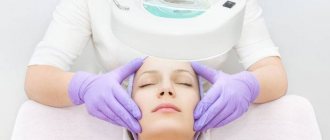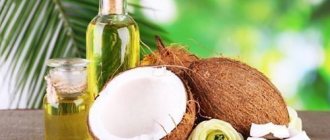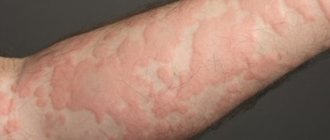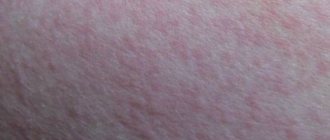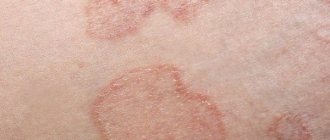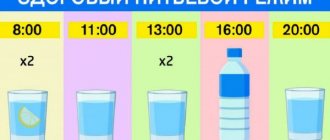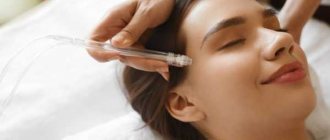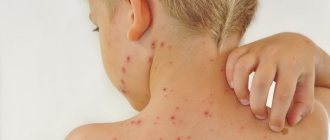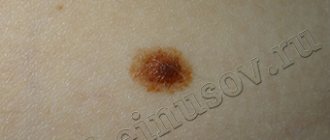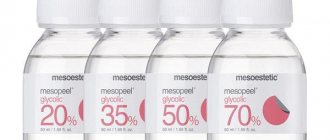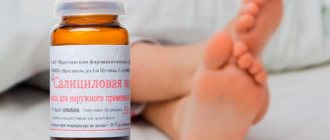What water procedures and bathing are possible for urticaria?
The skin of many people is prone to various types of rashes. Accompanied by itching and burning, blisters on the body indicate the manifestation of urticaria. The rashes remain on different parts of the body from several days to weeks, and may not disappear for months. For a person, this period is a difficult time of testing. The rash itches, leads to discomfort, and an unaesthetic appearance. A pressing question is asked by most patients: is it possible to wash with hives?
Before you start reading the article, watch the SPECIAL EDITION of the “Let Them Talk” program with Andrei Malakhov, about how Alice got rid of red dots forever in a couple... Find out more... "
Daily water procedures have become the norm for normal human life. Bathing or showering at least twice a day is common for most people. It turns out to be quite difficult to refuse water procedures while suffering from various ailments. Experts say that if you have hives, a person should bathe, but be sure to carry out the procedure correctly.
You can swim if you have hives, but you need to do it correctly.
Proper use of water procedures for urticaria
Urticaria is classified as an allergic disease. Blisters and rashes affect areas of the skin regardless of the gender and age of the person. Is it possible to wash with hives is of interest to a patient who is serious about health. If the illness is severe, the body temperature exceeds the norm, and is accompanied by Quincke's edema, experts categorically prohibit water procedures. In other cases, there is no prohibition on bathing; they even recommend spending time in the shower more often to relieve itching and burning sensations. If the pathology is of a thermal, cholinergic type, hot water should be avoided for the duration of the illness.
Basic rules for bathing during the active period of rashes
Experts do not prohibit taking a bath or shower, but they advise adhering to the basic rules:
- the water should not exceed 37 degrees, this temperature regime will prevent the blisters from spreading to other skin areas;
- Swimming under running cold or hot water is strictly prohibited;
- It is recommended to take a bath no more than once a week, the rest of the time to wash in the shower;
- an adult should be in the shower no longer than 15 minutes, a child up to 10 minutes;
- may sprinkle on hygiene products, make sure that the gel, soap, shampoo do not cause an allergic reaction to skin rashes, it is recommended to test the new product on a small area of skin;
- if you are prone to allergic reactions, you should purchase products from pharmacy kiosks marked “hypoallergenic”; their composition excludes dyes and fragrances, they have anti-inflammatory and antibacterial effects;
- It is forbidden to use washcloths or body scrubs during illness; they aggravate rashes by damaging the surface of the skin;
- It is advised not to wipe after bathing, but to blot the skin with soft towels.
After drying, nutrients (cream, oil) should be applied to the skin, but this should be done by carefully selecting the product so that it is hypoallergenic. Experts prohibit swimming:
- in case of intoxication of the body;
- with pustular nature of the rash.
Sea, swimming pool, sauna, bathhouse
Cream-wax for the prevention and treatment of dermatitis and urticaria “Cream ZDOROV”.
This unique natural product is the latest development of modern science, confirmed by leading dermatologists in the world. Its composition consists of 100% natural active ingredients:
- Olive oil
- Propolis
- Dead bee
- Bee venom
- Beeswax
- Siberian cedar resin
- Horse chestnut extract
- Bee moth
Suitable for adults and children, convenient to use at work, home and school!
The drug has been clinically tested and approved by the Ministry of Health of Russia, the USA, and Israel. Doctors' opinion..."
allrg.ru
Complications
If you neglect the problem and start treatment, dermatitis can have the following consequences:
- Deep ulcers on the skin;
- Purulent skin lesions (or pyoderma);
- Abscesses, purulent lesions of the subcutaneous fat layer.
This disease is not transmitted to another person and does not spread to healthy areas of the skin. However, there are cases where allergic dermatitis can be dangerous (if the allergen is poison ivy).
It is impossible to answer this question unequivocally, since everything will depend on the degree of neglect of the disease and the effectiveness of treatment.
Is it possible to wash if hives appear?
Is it possible to wash if you have hives? This is a question that worries people who, for some reason, are faced with this disease. By its nature, urticaria is characterized by rashes, itching and redness, so the bathing process should include precautions so as not to harm the skin. During the course of the disease, the patient experiences discomfort, which prevents him from leading a normal lifestyle. In the best cases, hives cause small red areas of the skin with blisters. But sometimes there may be too many such areas, as a result of which the patient’s skin is subjected to severe negative effects.
Not only adults can suffer from this common disease. Parents who are concerned about the health of their child during hives use various medications or folk remedies that can reduce the effect of the allergy. After all, children suffer from a more severe form of the disease with swelling or pain in the joints. When asking the question of why urticaria appears, it is impossible to give a definite answer, since there are many factors and causes, depending on the characteristics of the body.
Symptoms indicating urticaria
Urticaria is fairly easy to distinguish from any other allergic disease. The main feature is symmetrical blisters on areas of the skin, which in appearance resemble nettle burns or insect bite marks. Urticaria is accompanied by itching and redness around the affected areas. The rashes have the property of migration, that is, they can move from one area of the skin to another.
In addition, the disease is characterized by complete reversibility of the elements: white spots, hyperpigmentation or scars will not bother the patient after recovery. But in order not to delay the healing process, it is necessary to follow some simple rules that will protect the patient from increasing pain. For example, during the height of the illness, it is recommended to wear loose clothing that will not rub the body and injure the skin. Avoid belts or any other elements that may put pressure on your skin for a while. At the same time, it is necessary to ensure the unhindered passage of air, due to which the skin will “breathe” and you will feel comfortable.
Try to avoid stress and drinking alcohol. It is also better to leave heavy physical work for a while and do something light that does not cause possible inconvenience. During solar urticaria, sunbathing is prohibited and it is necessary to use products to protect the skin from the sun, and when urticaria occurs against the background of cold weather, protective creams against low temperatures must be used.
What are the main causes of hives?
Urticaria is a complex disease. Its appearance can be caused by various factors:
Depending on the characteristics of the body, patients may be predisposed to hives due to various foods or medications. These may be certain types of mushrooms or eggs containing allergenic components.
In cases of complications during pregnancy, the expectant mother experiences complex forms of urticaria. Therefore, identifying the cause is very important in order to prevent negative consequences and protect your body from diseases.
Some people who suffer from hives are intolerant to sunlight or cold temperatures. This could also be causing the problem.
Nervous tension or mental stress often causes itching and redness. Therefore, it is important to protect the internal state of the body without exposing it to stress or extreme fatigue.
Bathing for hives: tips and tricks
Everyone knows that contaminated skin is a favorable environment for the proliferation of bacteria and microbes, so swimming if you have hives is not even possible, but necessary.
The peculiarity of bathing is that inflamed skin must be handled carefully, without injuring the affected areas of the body. If you use cosmetics for the shower or bath, try to choose a product based on natural ingredients, such as herbs. Avoid choosing body cleansers that expose your skin to chemical ingredients.
In addition, pay attention to the water temperature. Washing with either cold or too hot water is dangerous, because it can aggravate the situation. It is recommended to swim for about 20 minutes. This is a safe period of time during which you will be sure that you have not harmed your body.
Apart from the hands or feet, hives can also appear on the face, which significantly reduces a person's self-esteem. In this case, you need to wash your face carefully every morning, trying not to damage weak areas of the skin.
During water procedures, experts advise using traditional medicine recipes based on herbs or other natural ingredients that will help reduce pain and relieve itching.
Water treatments for children
Children suffering from urticaria require careful care and treatment. The use of various bathing products is not allowed, as children's skin is more sensitive to chemical components.
It is recommended to use mild baby soap on areas where there is no rash or redness. If the infection has spread over most of the body, it is recommended to add herbal tinctures that will soothe the baby's skin. Calendula and chamomile, which is often used in the first years of a child's life, are good options.
Before bathing, parents need to check the condition of the bath. It must be cleaned of possible residues of household chemicals that can cause harm and cause an even greater allergic reaction. After bathing, it is recommended to wash the bath again.
It is worth noting the beneficial effects of sea water and salt on skin affected by urticaria. Therefore, if you have the opportunity to swim in the sea or simply add sea salt to the water while swimming, the itching, redness and blisters will disappear much faster. But remember to always consult with a specialist before using medications. This is especially true for a child.
Traditional medicine in the fight against urticaria
Folk recipes can be used both for external use and for internal use.
Diphenhydramine solution, salicylic acid or menthol alcohol are effective in combating itching. By rubbing these products into the skin, redness and discomfort will be less of a concern.
It is recommended to take 1 teaspoon of horseradish juice and bee honey 3 times a day.
Mint, which is poured with boiling water and infused, also benefits the patient’s body.
White mistletoe is a suitable ingredient for a decoction against urticaria. It should be consumed once a day, infusing mistletoe for 12 hours in cold water.
When taking a bath, you can add marjoram infusion to the water, which is first filled with boiling water.
https://www.youtube.com/watch?v=9nLF4E8Xztw
Ledum herb will help heal damaged skin if you add its decoction to water and take a 20-minute bath.
Preventive measures must be followed. A healthy lifestyle in any case is a reliable protection, because by eating right, playing sports and giving up bad habits, a person prevents not only urticaria, but also other diseases that are dangerous to the body.
In addition, you should not interact with allergens known to your body. And if you suffer from allergic reactions, but do not know their cause, you should identify the source that is an irritant to the body.
https://www.youtube.com/watch?v=6ncpLXRP2gI
In any medical matter, it is important to consult a specialist who recommends the necessary methods and medications. You should not fight the disease if you are not completely sure of the accuracy of the information. To carry out effective treatment and prevention, consult with an allergist-immunologist on all questions, and then you will know exactly why the itching with redness appeared, what treatment methods are best to use and whether it is possible to wash with hives.
Rate this article:
(No votes) Loading…
ProAllergiju.ru
Symptoms
Causes of the rash:
- Allergy.
- The baby could have eaten or inhaled some harmful substance, which caused the allergic process to begin;
- The body produces histamine or another substance that leads to inflammation.
Children's skin reactions may occur for the following reasons:
- poor nutrition;
- taking medications to which the body is allergic;
- uncomfortable, tight clothes;
- overheating or hypothermia.
These are external factors that cause blisters. The reason may also be internal. Most often this is an organ disease or a malfunction in the nervous system. For example, emotional excitement can cause hives.
Stages of the disease:
- inflammation in skin tissues;
- fluid accumulation;
- the appearance of swelling and rashes on the body.
Symptoms of urticaria in children:
• increasing severe itching on the skin in certain places; • blisters on the body; • the appearance of edema; • increased temperature, possible fever; • nausea, headache, vomiting, upset stool.
It is dangerous if the rash appears on the eyelids, mucous membranes of the eyes, lips, in the intestines or stomach. Photos of the affected areas of the body will not please anyone.
Treatment
The question of how to treat urticaria in a child can be answered depending on the stage of the disease. You need to see an allergist or dermatologist. The specialist will indicate the stage after examining the skin. If the rash in children goes away, you can show a previously taken photo of it.
The doctor can clarify:
• when the disease began; • symptoms; • whether there was treatment; • other diseases and reactions.
Treatment can be carried out:
• antihistamine tablets; • ointments for allergies; • diuretics to relieve swelling; • sorbent substances to reduce allergic reactions; • preparations with menthol to reduce itching; • prescription of diet.
It is important not to start the disease, so periodic examination by a doctor and prevention will be useful.
Is it possible to wash if you have hives?
Urticaria is a fairly common disease. Basically it is a type of allergic reaction. Many who have encountered this problem have a question: is it possible to swim with hives. Experts give a positive answer, while paying attention to a number of conditions and nuances related to the characteristics and origin of the disease.
The most important thing is to establish the cause of urticaria, so as not to cause a worsening of the condition, and here you cannot do without consulting a doctor. When an accurate diagnosis has been made, it is possible, and even necessary, to begin water procedures. If you have hives, you should bathe 1-2 times daily.
Basic Rules
Bathing with urticaria requires attention to preparation and the process itself.
1. Prepare the bath. Thoroughly rinse off any remaining detergents used during cleaning.
2. Monitor the temperature. It should be comfortable, approximately 37 degrees. Too high or low water temperatures can aggravate skin symptoms.
3. Choose your cleaning products carefully. Already affected skin does not need unnecessary irritants, so you should avoid fragrant multi-colored gels. You should wash with special products that do not cause allergies, or with baby soap. Make sure the pH level is neutral to the skin.
4. Eliminate mechanical impact. Do not use scrubbing agents or rough washcloths.
5. Limit your time. Try to keep it to 15 minutes.
6. Give preference to the shower. This will ensure that your body is not constantly exposed to water.
7. Rubbing is contraindicated. After completing the water procedures, gently pat your skin with a soft towel or let it dry.
8. After swimming. When the skin is dry, treat it with topical antihistamines.
Medicinal herbs and traditional methods
If you still decide to take a bath, then use special decoctions. Dries the skin well and relieves itching. For urticaria, decoctions of celandine, St. John's wort, chamomile, bay leaf, and tricolor violet are used. It is recommended to rinse the skin with decoctions of these herbs after taking a shower.
Strangely enough, people consider nettle decoction and baths with nettle brooms to be effective in the fight against urticaria. You can also add starch and soda to the water to relieve itching and redness.
Water urticaria
With this type of disease, bathing becomes very problematic. In people who are allergic to water, at the slightest contact with the allergen, a rash appears, the mucous membranes turn red and swell. To the question whether it is possible to wash with urticaria caused by water, the answer will also be positive. Even more stringent restrictions apply when swimming:
- bathing is reduced to 1-2 minutes;
- water must be boiled before bathing;
- use filtered water or from a clean natural source.
Immediately before performing hygiene procedures, you must take antihistamines. Lubricate existing affected areas with greasy ointment to avoid contact with water. You can use herbal decoctions.
Precautionary measures
Make sure you are not allergic to temperature changes. If your skin reacts to hot or cold, choose a comfortable temperature individually.
If the allergy is of plant origin, then you should be careful when using medicinal herbs.
As soon as you notice the situation getting worse, stop swimming immediately if you have hives.
Swimming is prohibited
You should not start water procedures if pustular formations appear on the body. To prevent the spread of infection, you must first get rid of them.
Do not swim until you are completely sure of the diagnosis. Streptoderma has symptoms similar to urticaria, but its cause is infection of the skin with streptococcus. With this disease, swimming is strictly prohibited.
During periods of exacerbation, avoid swimming in open water.
Children and urticaria
In the first years of life, young children are often susceptible to allergies, which manifest themselves in the form of hives. Parents begin to think about whether or not to bathe their child. The answer here is the same as for adults and the rules are the same.
Bathing the baby begins with the hands. In the absence of any negative reaction in the form of redness, wash the entire body. The already listed decoctions or a solution of potassium permanganate are also added to the water. After swimming, redness can be lubricated with a hypoallergenic cream containing zinc.
Despite the fact that hives are an unpleasant phenomenon, you should not deny yourself such pleasures as a refreshing shower and aromatic bath. Just follow these rules to make your life easier.
dermatologpro.ru
Is it possible to get dermatitis wet?
Contact with water on the affected areas of the skin usually causes an increase in the symptoms of the disease, and also provokes the spread of the lesion to other parts of the body. To figure out whether it is possible to swim with dermatitis in an adult and a child, you first need to determine which type of disease was diagnosed:
- With atopic dermatitis, bathing is not only possible, but necessary. The main requirement that must be observed is the use of not too hot and not too cold water.
- With seborrheic dermatitis, exacerbation can occur due to the use of hard chlorinated water. If you replace it with soft spring or thermal water, unpleasant symptoms may decrease.
- For contact dermatitis, you need to pay attention to the condition of the skin after contact with hygiene products - shower gel, soap. Perhaps they are the culprits for the appearance of symptoms of the disease.
- Is it possible to swim if you have allergic dermatitis? First you need to establish what exactly causes the allergic reaction. If you use herbal infusions for bathing, be sure to inform your doctor about this: some plants are precisely the triggers of allergic dermatitis.
Can people with urticaria swim and what can this lead to?
Hello dear readers. Very often, people develop various types of rashes on their skin, accompanied by burning and itching. A disease such as urticaria has these symptoms.
It can last a couple of days or months, and at the same time many people are concerned about the question: is it possible to bathe and wash during the illness? Will this cause complications? Let's try to understand this problem.
Can adults take a bath if they have hives?
Urticaria is an allergic disease that manifests itself in the form of blisters and rashes on the surface of the skin and mucous membranes.
There are several types of this disease, and in some of them, as well as in acute manifestations, you cannot take a bath.
Often the disease is accompanied by fever, chills, and Quincke's edema. During these exacerbations, washing is strictly prohibited.
Is it possible to swim with hives without fever? The answer is yes. This is due to the fact that if you refuse hygiene procedures during the illness, this will only worsen the itching and burning sensation due to skin contamination.
When scratching, you can damage the skin, and because of this, it is likely that infection will enter the body.
Note that with some types of urticaria (thermal, cholinergic), you should refrain from taking baths with hot water.
If you cannot refuse such a pleasant procedure, then you should adhere to several rules.
The water during bathing should not be more than 38 degrees. At this temperature, the rash will not spread over the surface of the skin. Until the disease subsides, avoid any contact with hot as well as cold water.
Remember, you should shower every day, but it’s better to take a bath once a week. In this case, washing should not take more than 20 minutes.
Make sure that you are not allergic to hygiene products (gels, shampoos, soaps). Test them on a small area of skin first.
The most optimal solution would be pharmaceutical hair and body washes intended for people with allergies (labeled “hypoallergenic”).
In addition, they have anti-inflammatory and antibacterial effects, and they also do not contain dyes or fragrances.
If your body is covered in blisters and rashes, then do not use washcloths or scrubs. They can damage the skin, making existing problems worse.
After bathing is completed, do not dry yourself, but blot the surface of the body with a towel. After this, you should apply a nourishing hypoallergenic cream (preferably purchased at a pharmacy) to the skin.
Are children allowed to wash and bathe?
This is practically the first question for parents of children with allergies. In fact, there are no contraindications to hygienic water procedures during illness, neither for adults nor for children.
You just need to thoroughly clean the bath before the procedure so that there are no household detergents that irritate the skin.
When bathing a child, you can use herbal decoctions that will reduce itching and burning of the skin (calendula, chamomile and others).
Remember, all washes must be approved by your pediatrician. Nowadays, pharmacies sell numerous gels and shampoos for babies that have an antiallergic effect.
How does sea water affect skin rashes?
Is it possible to swim in the sea if you have hives? This issue is acute in the summer, because urticaria can catch a person during vacation.
In general, sea water has a beneficial effect on all types of diseases, since the salt contained in it relieves swelling, itching, and after such bathing you can completely get rid of the disease. But remember, if you have a fever, swimming is contraindicated.
The exception is heat, cold, and solar urticaria. With the first and last, you should not stay in the open sun for a long time, as this will only worsen the situation.
If you are allergic to cold, then cool sea water will also not have a positive effect on your condition.
What to do if you are allergic to water?
Some people have watery urticaria. With this disease, bathing is very problematic.
During contact with water, such patients develop a rash, the mucous membranes swell and turn red. In this case, there are strict restrictions on swimming:
- Washing time is reduced to 2 minutes;
- Before the procedure, the water should be boiled to remove any metals and harmful substances from it;
- It is better to use filtered water or taken from a source for these purposes.
- The water should be warm, no more than 38 degrees.
Just before taking a bath or shower, take an antihistamine as prescribed by your doctor. Lubricate the already affected areas of the body with a greasy ointment or cream so that they do not come into contact with water. You can also use herbal infusions.
When is swimming prohibited?
You should not take a bath or shower if pustules form on your body. Get rid of them first, since at the slightest damage, pus can spread over the surface of the skin, causing infection of clean skin.
Do not swim until you are sure of the diagnosis - urticaria. There is a disease called streptoderma with similar symptoms. With this illness, swimming is completely prohibited.
As mentioned above, any water procedures are prohibited at elevated body temperature and swelling. To reduce it, take paracetamol.
It can be used for both children (in the form of syrup) and adults (tablets, capsules). If the fever does not go away within 5 days, you should consult a doctor.
During periods of exacerbation of urticaria, you should not swim in open, non-flowing bodies of water.
So, taking a shower every day, in the absence of certain contraindications, will only have a beneficial effect on your overall well-being: itching, redness, and swelling will decrease.
If you do everything correctly, following the above recommendations, you will be able to get rid of the symptoms of hives faster. Be healthy!
Author of the article: Anna Derbeneva (dermatologist)
Publication date: 01/08/2016
kozhatela.ru
Features of the disease
Urticaria, or urticaria, is an allergic skin reaction expressed in the form of blisters or swollen papules. They pour out one by one or en masse all over the body. The disease has a number of features:
- Everything that surrounds a person can become an allergen, from animal fur to changes in air temperature;
- skin rashes can go away within half an hour or linger on the body for up to six months;
- The blisters can be the size of a pinhead or cover a surface the size of the palm of your hand.
The conclusion suggests itself - if you have hives, you can wash yourself. Moreover, this is necessary so as not to aggravate an already difficult situation with a bacterial infection.
Is it possible to wash or take baths if you are sick?
For various skin rashes, adequate care is needed: special creams and ointments, hypoallergenic underwear and clothing, diet. But is it possible to wash if you have hives? After all, bathing can lead to skin irritation and aggravate the condition. Therefore, people with this disease should take a bath carefully, following some rules.
Bathing for urticaria - benefit or harm?
Hygienic measures are an integral part of the comfortable state of every person. You can and should swim if you have hives. After all, failure to maintain personal hygiene will lead to a secondary infection, and this will aggravate the patient’s condition. The rules for taking baths when you are ill are as follows:
- The water temperature should be about 37˚. There is no need to make the water too hot. It increases vascular permeability and after taking a bath the number of rashes will increase;
- When bathing, do not irritate the skin with excessive mechanical stress. You should use a soft washcloth and non-scrubbing detergents;
- Bathing time should not exceed 20 minutes;
- For washing it is necessary to choose hypoallergenic gels;
- After bathing, you should gently pat your skin dry with a soft towel, without rubbing;
- 5-10 minutes after the bath, you can apply the cream or ointment prescribed by the doctor;
- You should not take a bath often; it is better to give preference to a shower.
By following these simple rules, adults stop asking themselves the question of whether it is possible to wash with hives. Bathing does not lead to unpleasant consequences, but, on the contrary, improves the condition of the skin.
Ban on bathing
It is strictly forbidden to take baths if you have a pustular rash. The skin with urticaria is constantly inflamed, so favorable conditions are created for the proliferation of pathogenic microorganisms. When bacteria get on the skin, they lead to pustular diseases. Taking a bath with this complication is strictly prohibited, as there is a high probability of spreading infection.
Therefore, with purulent pustules, you should limit yourself to taking a shower. Moreover, areas with a purulent rash should be washed with a special washcloth or not used at all.
Allergy to water - what to do?
Water urticaria is a rare type of allergy in which a rash occurs after contact with poor-quality water. How to swim with water urticaria and is it possible to do it? Of course, without bathing a person cannot exist normally. However, water procedures should be taken according to special rules:
- The duration of the shower should be several minutes;
- water for washing should be boiled;
- It is better to wash with filtered water or from natural sources.
Effective therapeutic baths
Therapeutic bathing for urticaria is part of traditional medicine. Many medicine recipes are based on various herbs. So why not treat your skin to a soothing herbal bath?
Therapeutic baths for urticaria: how to take, method of preparation
Therapeutic baths for rashes should be taken on average once a week. The frequency of use depends on how the skin reacts to the product. As for the duration, the first procedure should not exceed 10 minutes. You should see how the skin reacts to the medicinal bath and whether the rash gets worse. Then you can gradually increase the duration of the procedure, but you cannot take a bath for more than 20-30 minutes.
If during a bath the itching intensifies, a burning sensation and other unpleasant sensations appear on the skin, the procedure should be stopped immediately, the body should be washed with clean water and a medicinal cream should be applied.
Methods for preparing baths to treat urticaria:
- Fill a bucket of nettles with hot water and boil for 15 minutes. Pour the resulting broth into the bath. Nettle is an excellent remedy for urticaria, the effectiveness of which has been tested by many patients;
- Pour boiling water over 300 grams of marjoram herb and leave for 30 minutes. Afterwards, strain the infusion and pour into the bath;
- Pour 300 grams of chamomile flowers into a liter of boiling water and leave for 15 minutes in a water bath. Strain and use to prepare a bath;
- Boil 300 grams of crushed oak bark in two liters of boiling water for 30 minutes. Strain and use to prepare medicinal baths;
- In equal proportions, take sage, chamomile, valerian root, string, St. John's wort, celandine and marjoram. For 1 liter of water in the bathroom you should take 5 spoons of the mixture. Boil in a saucepan, strain and pour into the prepared bath.
You should take medicinal baths in courses. If the skin tolerates the procedure well, then it can be carried out every other day in a course of 7-10 procedures.
After taking a therapeutic bath, the skin calms down, itching decreases, and the rash becomes less pronounced. Traditional medicine perfectly complements the traditional treatment of urticaria. However, if you are allergic to any herbs, taking herbal baths, making lotions and drinking infusions is strictly prohibited.
Read more
Folk remedies
Is it possible to cure hives with folk remedies?
Ointments
What ointments are best to use for hives.
Causes
Common causes of urticaria and rare forms of pathology.
Means and preparations
A list of the most effective remedies for combating urticaria.
Recent studies have shown that the consequences of urticaria can be extremely dangerous. If you do not have the opportunity to get an appointment with a qualified immunologist or allergist, we recommend that you familiarize yourself with the recommendations of V.N., Doctor of Medical Sciences, head of the Institute of Immunology of the Russian Federation. Abrosimovo (details) on the prevention and treatment of urticaria and its consequences.
To treat urticaria and eliminate its consequences, our readers recommend the remedy "". Unlike other remedies, Allergonix shows lasting and stable results, and also completely eliminates all the negative consequences of the disease. After using it, you will protect yourself from anaphylactic shock, Quincke's edema, eczema and psoriasis.
ProAllergen.ru
Folk remedies for safe bathing
Therapeutic baths for atopic dermatitis are quite effective. They help reduce inflammation in affected areas of the skin. The most common bath recipes include:
- Bath with birch buds and leaves, 200 gr. leaves and buds are poured with a liter of boiling water and infused for 3 hours. Next, strain and pour into the prepared bath.
- In the same way, a decoction of herbs such as celandine, violet, nettle, and string is infused.
- Bath of Cleopatra. A liter of milk is mixed with half a glass of unrefined olive oil. Pour the prepared mixture into the bath and take for about 15-20 minutes.
- Bath with sea salt. Add 5 tablespoons of salt to the bath and stir until completely dissolved.
- Starch bath: add 2-3 tablespoons of starch per liter of water. Pour the resulting mixture into the bath.
We invite you to familiarize yourself with Laser treatment of nail fungus - advantages and disadvantages of the procedure
Is it possible to wash, swim in the sea, sunbathe in the sun, or take a shower if you have hives?
Urticarial rash affects the skin and causes itching. During an exacerbation, the patient needs special skin care: natural clothing, medicinal ointments, cleanliness of the room. What about the bath and shower? Is it possible to wash with hives, and how to do it so as not to harm the skin?
Rules for a good bath
Until recently, doctors prohibited bathing in the bathtub or shower for the entire period of exacerbation. However, recently dermatologists and allergists have become much more loyal to body hygiene. Now patients are allowed to swim, but this must be done carefully.
- Is it possible to bathe in hot water if you have hives? Tip: buy a regular thermometer for bathing children. This way you can check the water temperature. Hot baths and showers are contraindicated for urticaria. Permissible temperature is 37-38 degrees. Hot water makes blood vessels even more permeable; in case of allergies, this is fraught with exacerbations and Quincke's edema.
- Do not rub your skin with a washcloth. Choose a soft sponge or replace it with your own palms.
- Scrubs and other exfoliating products are now prohibited for you.
- You must have your own towel. Soft, made of natural fabric - just what you need. Do not wipe off the moisture, but blot it. If you have taken a medicinal bath, you do not need to dry yourself.
- Inflamed skin needs quality cleansers. The best that can be recommended are gels, soaps, and shampoos for infants.
- Is it possible to shower if you have hives? During a relapse, refuse hygienic baths and take a shower.
- Bathing time is about 20 minutes.
- 15 minutes after the shower, you can apply medicinal products and moisturizer.
Causes of allergies. Memo
Restrictions
Some allergic skin conditions, or their complications, force the patient to be even more careful:
- If the scratches become infected and pustules form, you should not bathe in the bathroom. Limit yourself to a warm shower.
- Also, do not use a sponge - you will transfer the infection to other parts of the body. Lather your hands.
- Do not wash at elevated body temperature.
- Avoid swimming if you have Quincke's edema.
- For aquagenic urticaria (allergy to water), bathing is kept to a minimum: you should be able to “get over it” in a couple of minutes.
- Find out what type of water your skin is partial to. It is forbidden for you.
- Leave the water for bathing, or even better, boil it.
- Of course, this is an expensive pleasure, but at least during exacerbations, use filtered, purified water for bathing.
- 15 minutes after bathing, you can treat the skin with medicinal ointment and moisturizer.
It is important to show the rash to the doctor before the water changes the clinical picture. If you have not yet been diagnosed and treated, it is better to refrain from showering and bathing.
I’m curious, is it possible to go to the bathhouse if you have hives?
Swimming pool and sauna are contraindicated for allergy sufferers. But a bathhouse can greatly help out a patient with a relapse of cold urticaria. One of the folk recipes recommends steaming with a birch broom for hives - a birch broom made from nettles. Excellent tool!
Sea bathing: is it possible for hives?
Getting sick while on vacation can ruin your summer. And so the skin is covered with an incomprehensible rash, and then the trip to the south is disrupted... Or not? Is it possible to go to the sea with hives, or is it better to go to other places?
If you are not aqua-allergic and can tolerate sea water well, you need to go south. Is it possible to swim in the sea if you have hives? Undoubtedly yes. After all, salty water, saturated with iodine and other minerals, is healing for inflamed skin. An important condition: you must be healthy in all other respects. For example, fever or angioedema is best treated at home, under the supervision of your doctor.
Many patients note that after swimming in the sea, their rashes, inflammations, pustules begin to subside, and the itching calms down. However, with cold, aquagenic, and thermal urticaria, you will still have to choose another place to rest: the risks of getting a serious relapse are too great.
Is it possible to sunbathe if you have hives in the sun? For any form of the disease (especially if you are allergic to the sun), direct ultraviolet rays are contraindicated. Don't go to the beach during rush hour; the rest of the time, stay in the shade. Do not use deodorants, aromatic oils, or perfumes. Be sure to wear a hat and use products with a high UV filter. For walks, wear closed clothing.
If it’s a bath, then it’s useful
Both doctors and traditional healers offer medicinal baths to allergy sufferers. Is it possible for adults to wash themselves with hives in herbal infusions? Yes, if you tolerate the components you will use for the procedure well.
The first bath lasts about 15 minutes. Assess the skin reaction after the procedure: has the rash gotten worse? Gradually increase the time, bring the duration to half an hour. Monitor your sensations: if during a therapeutic bath you feel that the itching is getting stronger, rinse your body with clean water and select other ingredients.
- Nettle. Fill a bucket with fresh herbs and fill it with water. Bring to a boil and simmer for 15 minutes. Cool slightly, strain through a colander. Pour into the bath.
- Brew a pack of chamomile flowers in 3 liters of water, let it brew, strain. Pour into the bath.
- Brew a pack of oak bark like chamomile. Use for healing procedures.
Video. Treatment of urticaria with folk remedies
During an exacerbation of urticaria and during remission, hygiene is necessary for such sensitive skin. The only difference is how long you can swim and what water temperature you choose. The general rule is to take care of your skin. Don't cause a new rash. Be healthy!
Sea buckthorn face mask Honey-lemon face mask
Did you like the article?
Give it a class!
magical-skin.com
Clinical researches
The conducted clinical study proves the high efficiency, safety and tolerability of products for daily skin care of children with mild and moderate forms of atopic dermatitis and during remission, accompanied by a decrease in the quality of life of patients. As a result of therapy, a decrease in the activity of the inflammatory process, a decrease in dryness, itching and flaking was noted.
Based on the results of the clinical study, the placement of information on the packaging “Recommended by the St. Petersburg Branch of the Union of Pediatricians of Russia” was agreed upon.
Stages of eczema on the hands
As the disease develops, it goes through several stages:
- Erythematous stage – includes skin redness and itching;
The papulovesicular or vesicular stage manifests itself in the form of a rash of blisters with liquid;
Weeping eczema. During this stage, the bubbles burst, and in their place wounds form, releasing fluid;
- Crusting or dry eczema. At this stage, the wounds are covered with dry crusts of a grayish-yellow hue. At the same time, lesions may appear in other parts of the body.
Consumer Reviews
Marina Mironova (otzyvru.com)
“It so happened that my husband and I are both allergic, and our son’s allergy began to manifest itself from the maternity hospital - some kind of incomprehensible rash, then the skin became dry, I was afraid to use baby oil, and since I myself have been using La products for several years now - Cree, then she didn’t experiment with the baby either, and began using the “La-Cree” cleansing gel for bathing. What I like about it is that it is free of chemicals and hormones, and it cleanses delicate skin well and does not cause harm, which is very important for babies. And I use this gel to wash my face; after it, I have no itching, no flaking of my skin, this gel is now our common family remedy.”
Ana-ya otzovik.com
The La-Cri cleansing gel appeared in our house after a visit to an allergist. My eldest son (when he was 9 years old) developed acne on his shoulders. While we were undergoing tests to rule out allergies to detergents, the doctor recommended bathing and washing with this product. Our allergy turned out to be of “sweet” origin, but we continued to use the gel. When I was in the maternity hospital, I had to give soap, 10 diapers and wet wipes to the children's department (to care for my son, on the first day of his recovery). I gladly gave away this not yet started gel (thinking that it would take better care of my son's bottom). To my surprise, the next day, when they brought my son to me for good, no one returned the gel. I had to ask my husband to buy a new one. The ward mom said that they keep everything for themselves and they should have given something cheaper. Since birth I have been bathing my youngest son with this gel (now he is 3 months old). There are no allergies or rashes on the body. True, the shape of the dispenser is not very convenient when bathing a baby. But I got used to it. Cleansing gel “La-Cri” is a transparent liquid that smells something like a hospital ward after quartzing. I'm completely satisfied. We buy it at the pharmacy for 201 rubles. The instructions say that “has antiallergic, antipruritic, wound healing and anti-inflammatory effects. Approved for use in children."
Sources:
- B.A. Shamov, I.G. Safiullina, A.B. Beshimova, T.B. Shamov, Differential diagnosis of atopic dermatitis, journal of Practical Medicine, 2011 https://cyberleninka.ru/article/v/differentsialnaya-diagnostika-atopicheskogo-dermatita
- Fokina R.A., Atopic dermatitis: stages of development of classification forms, Siberian Medical Journal, 2007 https://cyberleninka.ru/article/v/atopicheskiy-dermatit-etapy-razvitiya-klassifikatsionnyh-form
- A.N. Pampura, A.A. Chuslyaeva, Modern approaches to the treatment of atopic dermatitis in children https:/cyberleninka.ru/article/v/sovremennye-podhody-k-terapii-atopicheskogo-dermatita-u-detey
Photos of dermatitis
Photo album on the disease
Sea, swimming pool, sauna, bathhouse
It is almost impossible not to notice hives on the skin. It can appear at the most inopportune moment, during vacation. While on the seashore, a person sees a rash and begins to panic and look for something to put on the blisters for complete, immediate disappearance. Consulting a specialist will help you find peace. The doctor will suggest a drug approved for your type of disease, which will lead to effective relief from red spots. Is it possible to cure hives with salty sea water? Is all vacationers interested?
If the disease is accompanied by fever, swimming in the sea is strictly prohibited. If the form of the disease is heat or cold, you should be extremely careful. Does cold urticaria make it worse?
Skin brighteners: is it worth using?
You can find recommendations for the treatment of atopic dermatitis using bleaching baths (with sodium hypochlorite - “Whiteness”). Data on the benefits of bleach baths is inconsistent. The theory is that a little bleach in the bath water can help kill bacteria and prevent skin infection. One tablespoon is enough. However, this is not suitable for everyone: the bleach fumes can irritate the lungs, so you should not try this if the patient has asthma or other lung problems.
